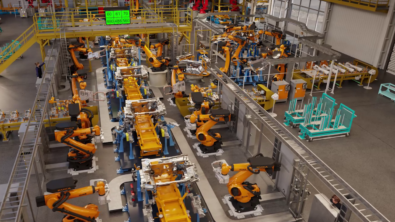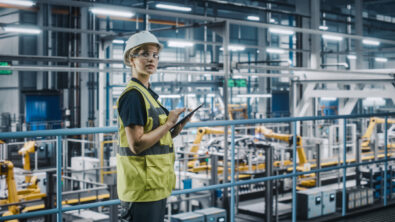Balancing sustainability demands in the aviation industry – Summary

The need to improve sustainability in the aviation industry is growing as the global temperature continues to rise and climate disasters worsen. Yet such an effort will impose significant demands when combined with the industry’s existing constraints surrounding product design, manufacturing, and validation. To help educate companies in balancing the demands of sustainability against these constraints, Todd Tuthill, Vice President for Aerospace and Defense Strategy and Marketing at Siemens Digital Industries Software, spoke at a webinar hosted by Aviation Weekly. In this webinar, he outlined why implementing sustainable strategies matters, identified the demands adopting sustainable practices require from companies, and discussed how they could be met with the assistance of the digital twin.
Importance of sustainability in aviation
Reducing greenhouse gas emissions is perhaps the most obvious and pressing reason for implementing sustainable aviation strategies. According to Todd, about 75% of greenhouse gas emissions consist of carbon dioxide (CO2), and commercial aviation currently contributes 2.5% of said CO2. That may seem small, but if no major intervention is enacted, that number is projected to rise up to 20% of global CO2 emissions by 2050. This will greatly interfere with the Paris Climate Agreement’s goal of keeping global warming below 1.5° Celsius. With that in mind, cutting emissions from every sector, including aviation, must be a top priority.
Yet there are other motivations that should incentivize companies to advance sustainability in aviation beyond cutting emissions. For one, Todd highlights how the increasing scarcity of resources is pushing the demand for a sustainable circular economy. Within a circular economy, products are designed with their full lifecycle in mind, including the means to reuse and recycle as much of the product as possible once it has reached end-of-life. This grants companies improved resource efficiency, which in turn gives a competitive advantage. He also talks about the increased desire from customers for sustainable methods of aviation. Customer sentiment has turned toward sustainability in recent years, evidenced by initiatives like Fly Net Zero and UK Jet Zero attempting to achieve net zero carbon emissions by 2050. There is an open market for greener aircraft fleets, so companies fulfilling that demand will attract investment and consumer interest. These economic incentives can be just as enticing as the ethical ones for aviation companies seeking to increase their sustainability.
Challenges to aviation sustainability
As vital as these issues are to address, there are a multitude of economic and technological obstacles that hinder potential solutions. Cost is one such obstacle, according to Todd, as the estimated price for achieving the Paris Climate Agreement’s goal is approximately $131 trillion, whereas the global GDP is estimated to be only around $85 trillion in 2020. While aviation emission are only a small portion of the climate crisis, the cost of a sustainable transition across the entire industry will still be expensive. Additionally, Todd explains how there are plenty of ideas for developing emissions-free aircraft, but the technologies behind them present more challenges. Sustainable aviation fuel (SAF), for example, is perhaps the easiest to attain quickly, but more expensive than current fuels and difficult to produce. In 2021, an estimated three million gallons of SAF was produced, in contrast with 26 billion gallons of fossil fuel produced for aviation. Fully electric aircraft are another approach, but the energy-to-weight ratios of batteries makes electrifying large, long-distance aircraft difficult. Hydrogen fuel is particularly attractive for its zero carbon emissions, but it is not expected to be applied en masse until the 2040s, and without the ability to generate large quantities of green hydrogen it is no cleaner an energy source than the fossil fuels it is produced from. There is also currently little infrastructure in place to support emissions-free aircraft in general, further preventing their large-scale adoption. To truly make commercial aviation sustainable companies will have to overcome these economic and technological hurdles.
Driving sustainability with the digital twin
The solution, presented in Todd’s webinar, lies in the application of the digital twin not just for the product, but toward what Todd calls sustainable industrial innovation, the idea to include the industry beyond the aircraft in the transformation to sustainability. Implementations of this idea embrace a system of systems approach that creates the infrastructure necessary to operate emissions-free aircraft, connected industrial ecosystems to build reliable supply chains, and holistic sustainability indicators to measure the impact the industry has on the wider fight against climate change. Utilizing the digital twin is key here, as companies can create virtual models of everything from products and factories to supply chains and more, allowing them to test methods early and gather data when they are operational. Companies will be able to simulate their entire sustainable initiatives and measure their impact before physical implementation. This can save money that would otherwise be spent on physical testing, as well as navigate the hurdles of innovative green technology.
Aviation’s sustainable future
The content of Todd’s webinar not only highlighted the importance of transforming the aviation industry into something more sustainable, but also provided an informative look into how digitalization can turn it into a reality. While the costs of transformation and technological hurdles may feel out of reach, simulating the new products and systems through the comprehensive digital twin will allow companies to prepare their initiatives better and avoid the pitfalls they might otherwise encounter. Through digitalization, the entire aviation industry can be remade for a cleaner, greener planet.
Check out the full webinar here.
Siemens Digital Industries Software helps organizations of all sizes digitally transform using software, hardware and services from the Siemens Xcelerator business platform. Siemens’ software and the comprehensive digital twin enable companies to optimize their design, engineering and manufacturing processes to turn today’s ideas into the sustainable products of the future. From chips to entire systems, from product to process, across all industries, Siemens Digital Industries Software is where today meets tomorrow.


